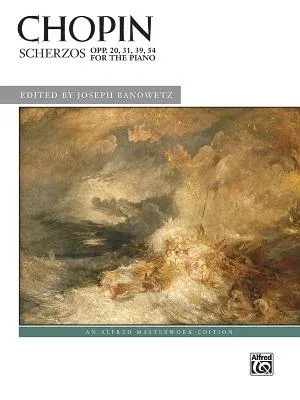Frédéric Chopin's Scherzos are a staple of the piano repertoire. In
them, Chopin abandons the lighthearted scherzo form of the Classical
period to capture powerful emotions. Scherzo No. 1, Op. 20, was composed
between 1830 and 1831, around the same time as his Études, Op. 10, and
Ballad No. 1 in G Minor, Op. 23. Scherzo No. 2, Op. 31, was composed
between 1835 and 1837. It may be the most famous of the set, and has a
memorable opening of hushed, questioning notes followed by dramatic,
loud chords. Scherzo No. 3, Op. 39, was composed in 1839 while Chopin
was on a winter trip to Mallorca. It was dedicated to Chopin's pupil
Adolf Gutmann. Scherzo No. 4, Op. 54, was composed in 1842. It is the
only Scherzo in a major key.
This newly engraved edition has been thoroughly researched, with
comparisons made between early sources, including the two existing
manuscripts for Scherzos 2 and 4. Chopin's fingerings, which have been
preserved from copies used by his students, have been included (marked
in italics), as well as editorial fingering suggestions. Prefatory
matter includes critical notes and performance suggestions, discussion
of rubato, and examples of Chopin's ornamentation with suggested
realizations. Detailed analysis of the form of each Scherzo is also
provided.
Joseph Banowetz has been described in Fanfare Record Review (U.S.) as a
giant among keyboard artists of our time and by Ruch Muzyczny (Warsaw)
as a virtuoso in the noblest sense of the word. He has been heard as
recitalist and orchestral soloist on five continents, in over 35
countries. Banowetz has internationally released over 35 commercial
recordings, two of which have received finalist Grammy nominations.
Banowetz is a graduate from the Vienna Academy for Music and Dramatic
Arts. Among his teachers have been Carl Friedberg (a pupil of Clara
Schumann's) and György Sándor (a pupil of Béla Bartók's).

